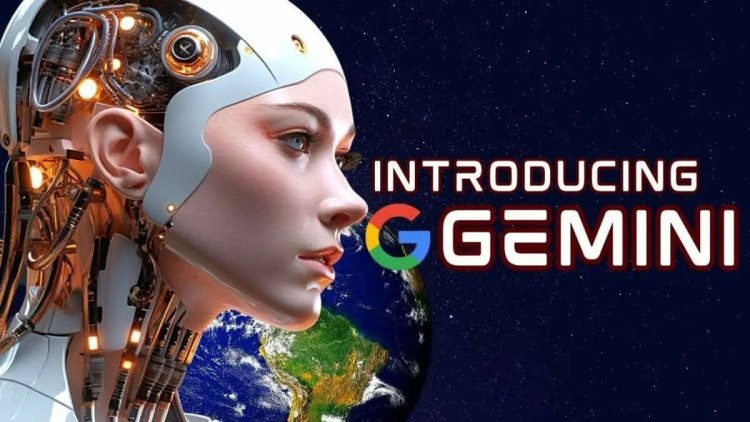Unleashing the Power of Google Gemini: A Comprehensive Overview
Unlock the potential of Google Gemini, the revolutionary AI platform designed to accelerate scientific discovery and innovation. Explore its capabilities, applications, and potential impact on various fields, from healthcare and materials science to climate change and AI research.

Introduction to Google Gemini
Google Gemini is a breakthrough in artificial intelligence (AI) that aims to organise the world's information and make it universally accessible and useful. With the exponential growth of information, there was a need for a deeper breakthrough in AI to effectively handle the scale and complexity of data.
Capabilities of Google Gemini
The largest and most capable model that Google has created is Gemini. It can understand various types of input and output, including text, code, audio, images, and videos. Unlike traditional multimodal models that stitch together text, vision, and audio models, Gemini is multimodal from the ground up, allowing for seamless conversations across modalities.
The mission of Google Gemini
Google's mission has always been to organise the world's information and make it universally accessible and useful. Gemini is a significant step towards achieving this mission by providing a truly universal AI model that can comprehend and process information in different modalities.
The need for breakthroughs in AI
As information has become more complex and abundant, there is a need for a breakthrough in AI to effectively handle and make sense of the vast amount of data available. Gemini addresses this need by offering advanced capabilities in understanding and reasoning over multimodal inputs.
Importance of Multimodal Capabilities
The world we live in and the media we consume are multimodal, engaging multiple senses such as text, vision, and audio. Gemini's multimodal capabilities allow it to understand and process information in a way that aligns with how humans perceive and interact with the world.
By combining different modalities, Gemini can provide more comprehensive and accurate responses, making it a powerful tool for various applications.
The ability of Gemini to handle multimodal inputs is a significant advancement in AI and distinguishes it as Google's biggest and most capable model.
Gemini's Impressive Benchmarks
Comparison of Gemini Ultra and GPT 4 in various subject areas
Gemini Ultra has demonstrated its superiority over GPT 4 in multiple subject areas. In terms of general capabilities, Gemini Ultra received a 90% score compared to GPT 4's 86.4%. Gemini Ultra also outperformed GPT 4 in reasoning tasks, with a slight advantage in the Big Bench Hard category. While GPT 4 achieved 87.8% in the H-SWAG category, Gemini Ultra's score of 88.7% is still highly commendable.
Gemini's performance is as good as that of expert humans in multiple benchmarks.
Gemini Ultra's performance in various subject areas is remarkable. Gemini demonstrated the ability to match the expertise of human experts in all 50 subject areas tested, making it as good as the best expert humans in those fields. This achievement is a testament to the model's advanced capabilities and its potential to revolutionise multiple industries.
Gemini's available in three sizes: Ultra, Pro, and Nano
Gemini is available in three sizes to cater to different needs. Gemini Ultra is the most capable and largest model, designed for highly complex tasks. Gemini Pro is the best-performing model for a broad range of tasks. Gemini Nano, on the other hand, is the most efficient model for on-device testing.
Potential for developers and enterprise customers to refine and utilise Gemini
Gemini's impressive capabilities provide developers and enterprise customers with the opportunity to refine and utilise the model for a wide range of applications. With Gemini as a foundational building block, developers and customers can explore creative ways to enhance and customise Gemini's capabilities to suit their specific needs. The potential for innovation and advancement with Gemini is limitless.
Safety and Responsibility in Gemini
-
The importance of safety and responsibility in multimodal capabilities
-
Proactive policies and rigorous testing to prevent harm
-
Considerations for image-text combinations
-
Building safety from the beginning
As Gemini pushes the boundaries of AI capabilities, safety and responsibility are paramount considerations in its development. With its multimodal capabilities, Gemini aims to provide users with a seamless and powerful experience across various modalities. However, this also raises the need for safety measures to prevent potential harm.
Google DeepMind, the team behind Gemini, understands the importance of proactive policies and rigorous testing to ensure the responsible use of the model. By identifying potential risks and developing appropriate safeguards, they work towards preventing any unintended negative consequences.
One specific consideration in Gemini's development is the combination of images and text. While an image or text may be innocuous on its own, the combination can sometimes result in offensive or hurtful content. To address this, Google DeepMind incorporates policies and filters to mitigate such risks and maintain a safe user experience.
Furthermore, safety is a fundamental aspect built into Gemini from the beginning. By embedding safety measures in its development process, Google DeepMind aims to create a model that prioritizes user well-being and protects against potential harm.
Gemini's Contributions to AI Breakthroughs
Google's role in foundational breakthroughs in AI
Google has been at the forefront of many foundational breakthroughs in AI over the past decade. Gemini continues this tradition by pushing the boundaries of AI capabilities and introducing advanced multimodal models.
Gemini's monumental engineering task
Gemini represents a monumental engineering task, combining text, code, audio, images, and videos seamlessly. Unlike traditional multimodal models, Gemini is multimodal from the ground up, enabling conversations across modalities.
Gemini is a step toward the company's mission
Gemini is a significant step towards Google's mission of organizing the world's information and making it universally accessible and useful. By providing a universal AI model, Gemini enhances knowledge and access to information for all.
Enabling more knowledge and access to information for all
Gemini's multimodal capabilities enable more comprehensive and accurate responses, making it a powerful tool for various applications. It enhances knowledge and access to information, benefiting users across different fields and industries.
Multimodal Capabilities of Gemini
Gemini's multimodal capabilities are truly impressive and demonstrate the power of AI in understanding and processing information across various modalities. With Gemini, users can experience seamless conversations and interactions that align with how humans perceive and interact with the world.
Examples of Gemini's multimodal capabilities include image recognition, language processing, and code generation. Gemini can analyse and understand images, allowing users to ask questions about objects, scenes, or even specific details within an image. It can also process and generate natural language, providing detailed responses and explanations based on user queries or prompts.
Furthermore, Gemini's code generation capabilities enable it to assist users with tasks such as creating web apps or generating blog posts. It can understand instructions, extract relevant information, and even generate code or visual elements to enhance user experiences.
By combining different modalities, Gemini enhances user experiences and provides more comprehensive and accurate responses. This makes it a valuable tool in various domains and industries, including education, research, content creation, and more.
Overall, Gemini's multimodal capabilities revolutionise the way we interact with AI systems, offering a new level of understanding and engagement. Its benefits extend across different fields, empowering users to explore and leverage AI in innovative ways.
Gemini's Technical Report and Future Innovations
Gemini's technical report provides a deep dive into the capabilities and advancements of Google's multimodal AI model. Here are some key highlights from the report:
A deep dive into Gemini's technical report
The technical report explores Gemini's ability to handle long sequences of data with a context length of 32,768 tokens. This enables the model to effectively utilise context information throughout the entire length of the text, providing accurate and comprehensive responses.
Context length and handling of long sequences
Gemini's impressive handling of long sequences was tested using a synthetic retrieval test, where it achieved 98% accuracy in retrieving values from a large string of text. This demonstrates the model's effectiveness in utilising context information across its full context length.
Reasoning, code generation, and chart understanding capabilities
Gemini showcases advanced reasoning capabilities, allowing it to generate bespoke interfaces, answer complex questions, and even understand and generate code. The model's chart understanding capabilities enable it to interpret data from charts, providing detailed insights and generating informative visualisations.
Video understanding and interaction with the physical world
Google DeepMind is exploring the integration of Gemini with robotics to enable multimodal interaction with the physical world. This exciting area of research aims to combine touch, tactile feedback, and reinforcement learning techniques to create AI agents that can physically interact with and manipulate objects.
Next steps and promising future innovations
Gemini is just the beginning of Google's advancements in AI. The technical report hints at future innovations and rapid advancements in the field. Google DeepMind's focus on reinforcement learning, planning, and searching techniques suggests that we can expect groundbreaking developments in future versions of Gemini.



 admin
admin 










